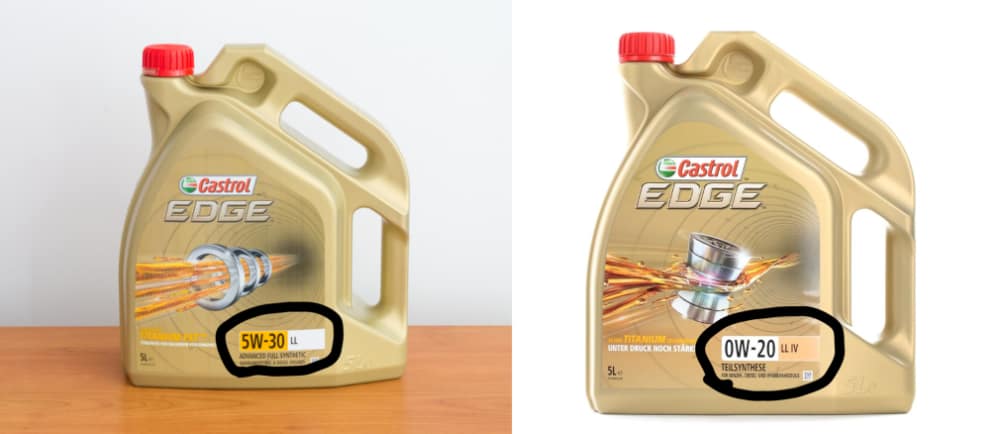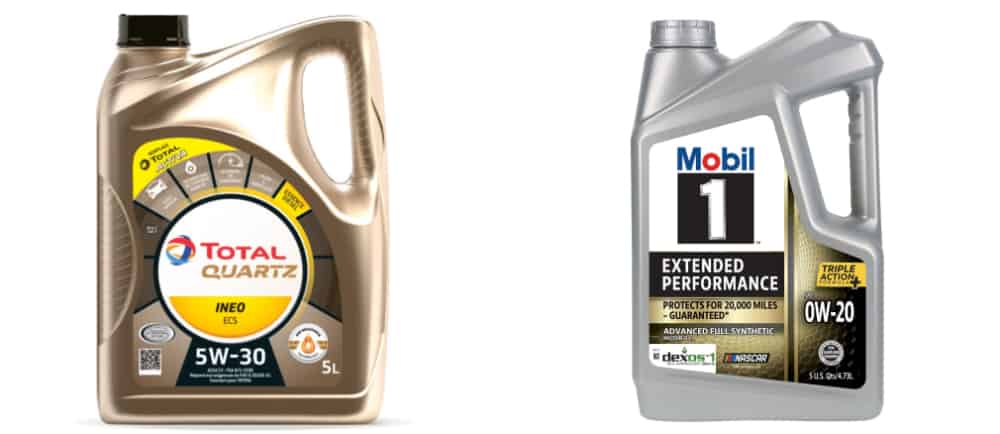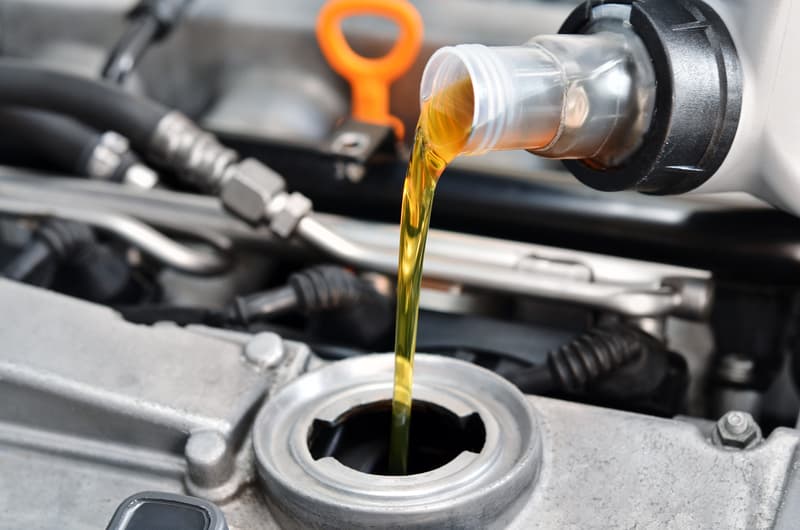
When it comes to motor oil, two of your options are 5W-30 and 0W-20. If you’re here, you’re probably wondering if you should replace 0W-20 with 5W-30. After all, 5 is higher than 0, right?
You can use 5W-30 instead of 0W-20 in most cases. Generally, 0W-20 is more suitable for colder climates, while 5W-30 works better under higher temperatures. However, you should stick to your manufacturer’s recommended oil to protect your warranty.
This article will help you understand how the two oils are different, how they affect your engine, and what to look for in new oils so you can buy the right one when it’s time to change again.
What To Expect if You Use 5W-30 Instead of 0W-20
Engine oils play an important role in the performance and longevity of a motor vehicle as follows.
- They lubricate the moving parts of the engine and help to prevent corrosion.
- They prevent your car from overheating.
- They are responsible for preserving the engine’s fuel efficiency.
In fact, engine oils are so important that they’re usually classified as a “power train” part.
To make the most of your engine oil, you need to use high-quality synthetic motor oil. Since 5W-30 and 0W-20 are the most common motor oils, you need to know their differences to know which one to use.
Differences Between 5W-30 and 0W-20

Viscosity
The primary difference between 5W-30 and 0W-20 is their viscosity.
Viscosity refers to a liquid or gas’ resistance against flow. This is an important quality of motor oils because it determines how well they will flow within your engine under different temperatures.
Luckily, you can tell how viscous your 5W-30 or 0W-20 is by their name.
See, “5W-30” and “0W-20” aren’t just random alphanumeric symbols. They’re based on the SAE J300, which are standards set by the Society of Automotive Engineers (SAE) to classify engine oils according to viscosity.
The reason for these different grades is that oils expand under high temperatures and thicken under low ones. The extent to which this happens depends on — you guessed it — the oil’s viscosity.
Prior to the advent of oils like 5W-30 and 0W-20, vehicle owners needed to change their oil depending on the season. Otherwise, the oil would turn into gooey muck during winter and have a watery consistency during summer.
As a result, multi-grade oils were developed to have different viscosities under extreme temperatures. That’s where the SAE J300 naming system comes in.
In “5W-30” and “0W-20,” the first character refers to the level of viscosity. So, 5W-30 is more viscous than 0W-20.
The “W” means both 5W-30 and 0W-20 are winter-grade oils.
The last two numbers denote how viscous both oils are at 100°C (212°F). In other words, 5W-30 is still more viscous than 0W-20 even at the highest allowable temperature.
So what does this all mean in practice?
Purpose and Performance Under Extreme Temperatures
5W-30 is designed for light diesel and gasoline engines. It cannot operate at temperatures lower than -30°C (-22°F). However, it’s recommended you keep it at temperatures above 5°C or (41°F).
0W-20 is also designed for light gasoline and diesel engines. It can tolerate slightly lower temperatures than 5W-30, being able to perform at -35°C (-31°F). Still, you should probably use it at a temperature no lower than 0°C.
Given these characteristics, using 5W-30 instead of 0W-20 during low-temperature conditions isn’t recommended.
On the other hand, in areas with mild winters and hot summers, 5W-30 will offer better protection than 0W-20. This is because 5W-30 will retain its viscosity under temperatures up to 35°C (95°F) better than 0W-20, which has a temperature limit of 30°C (86°F).
When To Use 5W-30 Instead of 0W-20 (and Vice Versa)
When it comes to motor oil, there’s no one-size-fits-all answer. That’s why it’s important to always consult your car’s owner’s manual to find the right oil for your vehicle.
That said, using 5W-30 is generally a good idea if one or more of the following conditions apply.
- Your car has an engine with a displacement of 2.0 liters (2000 ml) or less.
- You’re driving your car during the summer months or hotter days of the week.
- You’re regularly driving your car on dry roads.
On the other hand, 0W-20 is specifically formulated to provide superior performance in severe cold weather conditions. So, if you live in an area that regularly sees winters, this motor oil is the best option.
Can I Mix 0W-20 With 5W-30?
Although 0W-20 and 5W-30 can be mixed in theory due to their similar viscosities, I do not recommend doing this.
Mixing different oils can decrease lubricant quality and engine performance. In some cases, it can even cause sludge to form in the engine.
If you’re wondering whether you can use 10W40 instead of 5W-30, read this article.
How Long Do the 0W-20 and 5W-30 Oils Last?
As you know, changing your oil regularly is vital to the optimal performance of your engine. But how “regularly” should you change oils like 0W-20 and 5W-30?
In general, the recommended mileage for synthetic oil brands is 6000 miles (10,000 km). However, some performance oils can stretch up to 20,000 miles (32,187 kilometers).
If you want a specific timeline for changing your motor oil regardless of its mileage, it’s a good idea to replace your oil every 12 months or so. Otherwise, the oil’s quality will deteriorate along with its ability to lubricate your engine.
Types of Engine Oils
Various engine oils are available on the market. The most common types are synthetic, semi-synthetic, and mineral.
Synthetic engine oils are the most popular because they offer increased performance and durability. They also tend to be less expensive than other types of engine oil, but they tend to wear out faster.
Semi-synthetic engine oils are a good compromise between synthetic and mineral oils. They offer good performance and durability but don’t last as long as the former.
Mineral engine oils are the oldest type of engine oil, and they offer the best fuel efficiency. They tend to be less expensive than synthetic or semi-synthetic oils. However, they probably won’t last as long.
How To Choose Engine Oils

The best way to choose engine oil is to check your car manual. However, there are a few general considerations as well.
Car Make and Model
Many manufacturers are now using synthetic oils, so it’s important to know which type is best for your car’s specific make and model.
Keep in mind that different models within the same make may require slightly different oils. If you’re unsure, consult with an expert
Driving Conditions
It’s important to consider driving conditions when choosing the best oil for your car, as these can affect how much pressure is put on your engine — and, therefore, what type of oil you should use.
For example:
- What is the climate like where you live? Is it hot or cold?
- Do you frequently drive on dirt roads or in hilly areas?
Availability of Oil
You should also consider the availability of the oil you want for your vehicle. While it’s ideal to use the oil recommended by the manufacturer, it may not always be practical or easy to find. So, you’ll have to make do with a viable substitute.
However, it’s important to remember that using oil not recommended by the manufacturer may not provide the same level of protection and performance to your car. So, you should be extra careful and do your homework before making a decision.
Viscosity Grade
It’s also important to consider the oil’s viscosity grade. Oils with higher viscosity are better suited for hot temperatures because they flow more slowly and create a protective film around the engine components.
On the other hand, oils with a lower viscosity flow more easily and are better suited for cold climates.
Best Engine Oils
Not sure which engine oil to pick from all the options available? Below, I’ve put together a list of recommendations from Amazon.
Mobil 1 Extended Performance Full Synthetic Motor Oil 5W-30

Mobil 1 Extended Performance 5W-30 motor oil will protect your engine for up to 20,000 mi (approx. 32,187 km).
You can be sure it can deliver what it promises because it meets ILSAC GF-6 standards to keep your engine in good shape for as long as possible.
You can check the current price on Amazon here.
Valvoline Advanced Full Synthetic SAE 5W-30

If you’re looking for a decent 5W-30 motor oil, I recommend this one. It offers 40 percent more protection from wear than the industry standard, an above-average ability to help keep your engine clean, and meets all the necessary standards for motor oils.
You can check the current price on Amazon here.
Pennzoil Ultra Platinum Full Synthetic 5W-20 Motor Oil

If you need a 5W-20 oil instead, this one’s a good choice. With this, you can drive your car for up to 550 more miles (885 km), which is a significant boost in fuel efficiency.
Like the 5W-30 oil, it has the ability to withstand relatively high temperatures compared to many other motor oils.
You can check the current price on Amazon here.
Final Thoughts
You can use 5W-30 instead of 0W-20 because these oils have almost similar viscosities. However, it’s better to use 0W-20 for colder winter climates and 5W-30 for hotter climates.
The 5W-30 is heavier than the 0W-20 and will therefore better dissipate heat at higher temperatures.
In any case, I recommend using the manufacturer-recommended oil to protect your warranty.
